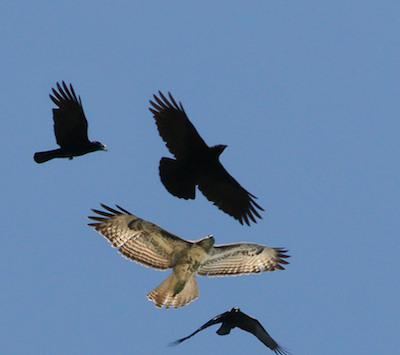July 20: Witness to a Bird Mobbing
 My daughter and I witnessed a bird mobbing in the field at BRLT’s Oak Point Farm a few days ago. We were obliviously admiring wildflowers when “WHOOSH”, just inches from our heads a red-tailed hawk came streaking through at full speed. Before we had time to register what had just happened, “CAWWWW” several black crows buzzed by us, following the hawk. “What was that all about?” my daughter asked. Our eyes followed the birds and I quickly realized what we were witnessing. The crows were mobbing the hawk, chasing after it in an attempt to scare it away.
My daughter and I witnessed a bird mobbing in the field at BRLT’s Oak Point Farm a few days ago. We were obliviously admiring wildflowers when “WHOOSH”, just inches from our heads a red-tailed hawk came streaking through at full speed. Before we had time to register what had just happened, “CAWWWW” several black crows buzzed by us, following the hawk. “What was that all about?” my daughter asked. Our eyes followed the birds and I quickly realized what we were witnessing. The crows were mobbing the hawk, chasing after it in an attempt to scare it away.
Mobbing is a bird behavior recorded in a wide range of species, but is most often seen among crows, gulls, and terns. When these birds spot a predator like a hawk or owl, they start to emit alarm calls and fly directly at it, hoping to force it to leave the area. It usually starts with one or two birds and gradually builds up in numbers, sometimes with a variety of species joining in. While we saw the hawk being mobbed in flight, predators may also be attacked on the ground or while perched in a tree. Rarely do the birds make physical contact.
So why do birds mob? There are several reasons, the most obvious being to protect themselves and their young. A predator will have a hard time sneaking up on prey if a bird blows its cover with loud alarm calls. This noisy mobbing will also help younger inexperienced birds understand the danger of a predator. Some recent research has also shown that mobbing might give males the chance to advertise their best physical qualities, in an effort to impress potential mating partners.
Predator birds are not the only animal at risk of being mobbed, as prey birds will mob anything they consider to be a danger. Cats, foxes, snakes, and even humans have the pleasure of being on the receiving end of this fury. I remember that my sister had to change her running route to avoid a red-winged blackbird that would dive bomb her anytime she got too close to his post in a cornfield. She had nightmares for months. Even inanimate objects like paint cans and statues can experience the wrath of mobbing birds.
Is it dangerous for a small bird to mob a large bird? Mobbing behavior is less risky than it appears, provided they keep an eye on the predator and don’t take too many chances. Smaller birds are often faster and more agile than larger birds, so it would be difficult for the mobbing bird to be captured. Another factor is that it wouldn’t be worth the energy a large bird would have to spend in order to kill and possibly consume a smaller bird. Therefore, it is just easier for the bird being harassed to leave the area.
So there you have it, next time you see a group of birds with some impressive aerial swoops, dive bombs, and ear shattering shrieks, you might just be witnessing a bird mobbing.




